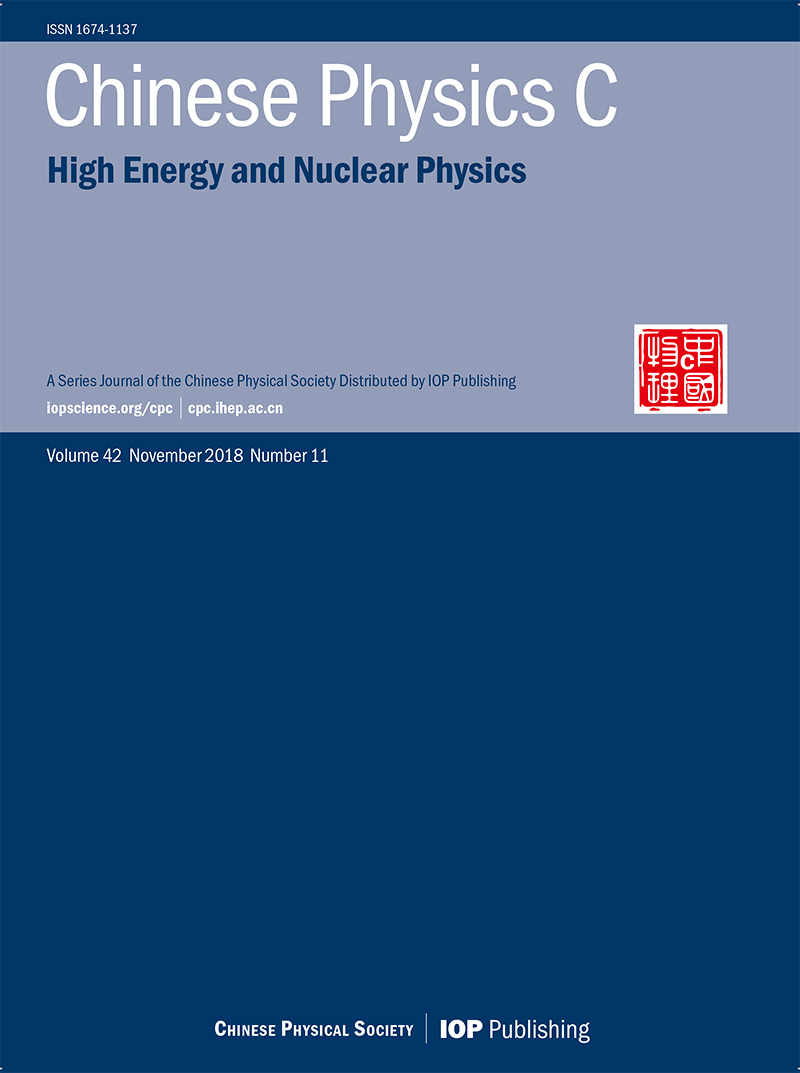2019 Vol. 43, No. 4
Display Method: |
2019, 43(4): 043001. doi: 10.1088/1674-1137/43/4/043001
Abstract:
Higgs boson production in association with a photon (H+\begin{document}$ \gamma $\end{document} ![]()
![]()
\begin{document}$ \gamma $\end{document} ![]()
![]()
\begin{document}$ \sqrt{s}=13 $\end{document} ![]()
![]()
\begin{document}$ \gamma $\end{document} ![]()
![]()
Higgs boson production in association with a photon (H+
2019, 43(4): 043002. doi: 10.1088/1674-1137/43/4/043002
Abstract:
The discovery of the Higgs boson with its mass around 125 GeV by the ATLAS and CMS Collaborations marked the beginning of a new era in high energy physics. The Higgs boson will be the subject of extensive studies of the ongoing LHC program. At the same time, lepton collider based Higgs factories have been proposed as a possible next step beyond the LHC, with its main goal to precisely measure the properties of the Higgs boson and probe potential new physics associated with the Higgs boson. The Circular Electron Positron Collider (CEPC) is one of such proposed Higgs factories. The CEPC is an e+e− circular collider proposed by and to be hosted in China. Located in a tunnel of approximately 100 km in circumference, it will operate at a center-of-mass energy of 240 GeV as the Higgs factory. In this paper, we present the first estimates on the precision of the Higgs boson property measurements achievable at the CEPC and discuss implications of these measurements.
The discovery of the Higgs boson with its mass around 125 GeV by the ATLAS and CMS Collaborations marked the beginning of a new era in high energy physics. The Higgs boson will be the subject of extensive studies of the ongoing LHC program. At the same time, lepton collider based Higgs factories have been proposed as a possible next step beyond the LHC, with its main goal to precisely measure the properties of the Higgs boson and probe potential new physics associated with the Higgs boson. The Circular Electron Positron Collider (CEPC) is one of such proposed Higgs factories. The CEPC is an e+e− circular collider proposed by and to be hosted in China. Located in a tunnel of approximately 100 km in circumference, it will operate at a center-of-mass energy of 240 GeV as the Higgs factory. In this paper, we present the first estimates on the precision of the Higgs boson property measurements achievable at the CEPC and discuss implications of these measurements.
2019, 43(4): 043101. doi: 10.1088/1674-1137/43/4/043101
Abstract:
A future Z-factory will offer the possibility of studying rare Z decays\begin{document}$ Z\rightarrow l_1l_2 $\end{document} ![]()
![]()
\begin{document}$ l_2\rightarrow l_1\gamma $\end{document} ![]()
![]()
\begin{document}$ Z\rightarrow l_1l_2 $\end{document} ![]()
![]()
\begin{document}$ \delta^{12} $\end{document} ![]()
![]()
\begin{document}$ \delta^{13} $\end{document} ![]()
![]()
\begin{document}$ \delta^{23} $\end{document} ![]()
![]()
\begin{document}$ l_2\rightarrow l_1\gamma $\end{document} ![]()
![]()
\begin{document}$ Z\rightarrow l_1l_2 $\end{document} ![]()
![]()
\begin{document}$ M_D^W $\end{document} ![]()
![]()
\begin{document}$ Z\rightarrow l_1l_2 $\end{document} ![]()
![]()
\begin{document}$ Z\rightarrow e\tau $\end{document} ![]()
![]()
\begin{document}$ Z\rightarrow \mu\tau $\end{document} ![]()
![]()
A future Z-factory will offer the possibility of studying rare Z decays
2019, 43(4): 043102. doi: 10.1088/1674-1137/43/4/043102
Abstract:
At the designed circular electron-positron collider (CEPC), similar to the hadron collider, the angular distribution coefficients of the decay lepton pair from the produced Z(W) boson in\begin{document}$ e^+ e^- $\end{document} ![]()
![]()
\begin{document}$ \theta_Z $\end{document} ![]()
![]()
\begin{document}$ \theta_W $\end{document} ![]()
![]()
\begin{document}$ \theta_Z $\end{document} ![]()
![]()
At the designed circular electron-positron collider (CEPC), similar to the hadron collider, the angular distribution coefficients of the decay lepton pair from the produced Z(W) boson in
2019, 43(4): 043103. doi: 10.1088/1674-1137/43/4/043103
Abstract:
We revisit the thermal Majorana dark matter from the viewpoint of the minimal effective field theory. In this framework, analytical results for dark matter annihilation into Standard Model particles are derived. The dark matter parameter space, subject to the latest LUX, PandaX-II and Xenon-1T limits, is presented in a model-independent way. Applications to the singlet-doublet and MSSM are presented.
We revisit the thermal Majorana dark matter from the viewpoint of the minimal effective field theory. In this framework, analytical results for dark matter annihilation into Standard Model particles are derived. The dark matter parameter space, subject to the latest LUX, PandaX-II and Xenon-1T limits, is presented in a model-independent way. Applications to the singlet-doublet and MSSM are presented.
Global constraints from RHIC and LHC on transport properties of QCD fluids in CUJET/CIBJET framework

2019, 43(4): 044101. doi: 10.1088/1674-1137/43/4/044101
Abstract:
We report results of a comprehensive global\begin{document}$ \chi^2 $\end{document} ![]()
![]()
\begin{document}$ p_T<2 $\end{document} ![]()
![]()
\begin{document}$ \alpha_c $\end{document} ![]()
![]()
\begin{document}$ c_m $\end{document} ![]()
![]()
\begin{document}$ \chi^2(\alpha_c,c_m) $\end{document} ![]()
![]()
\begin{document}$ R_{{\rm AA}}, v_2 $\end{document} ![]()
![]()
\begin{document}$ \chi^2<2 $\end{document} ![]()
![]()
\begin{document}$ \alpha_c \approx 0.9\pm 0.1 $\end{document} ![]()
![]()
\begin{document}$ c_m\approx 0.25\pm 0.03 $\end{document} ![]()
![]()
\begin{document}$ v_3 $\end{document} ![]()
![]()
\begin{document}$ \chi^2 $\end{document} ![]()
![]()
\begin{document}$ \hat{q}(E,T)/T^3 $\end{document} ![]()
![]()
\begin{document}$ \eta/s \sim T^3/\hat{q}\sim 0.1-0.2 $\end{document} ![]()
![]()
\begin{document}$ T_c $\end{document} ![]()
![]()
\begin{document}$ p_T<2 $\end{document} ![]()
![]()
We report results of a comprehensive global
2019, 43(4): 044102. doi: 10.1088/1674-1137/43/4/044102
Abstract:
We study the properties of proton rich nuclei reported as proton emitters in the region from I to Bi with Z = 53 to 83 and N = 56 to 102 as a crucial application to the existence of exotic nuclei. The effective relativistic mean-field formalism (E-RMF), with NL3, FSUGarnet, G3 and IOPB-I interactions, is adopted for analysis of the ground state properties of proton emitters. Furthermore, in the E-RMF background, the Wentzel-Karmers-Brillouin (WKB) barrier penetration method is used for the calculation of proton emission half-lives. It is found that the calculated half-lives are in good agreement with the experimental results for all emitters considered in this study.
We study the properties of proton rich nuclei reported as proton emitters in the region from I to Bi with Z = 53 to 83 and N = 56 to 102 as a crucial application to the existence of exotic nuclei. The effective relativistic mean-field formalism (E-RMF), with NL3, FSUGarnet, G3 and IOPB-I interactions, is adopted for analysis of the ground state properties of proton emitters. Furthermore, in the E-RMF background, the Wentzel-Karmers-Brillouin (WKB) barrier penetration method is used for the calculation of proton emission half-lives. It is found that the calculated half-lives are in good agreement with the experimental results for all emitters considered in this study.
2019, 43(4): 044103. doi: 10.1088/1674-1137/43/4/044103
Abstract:
Within the framework of the improved quantum molecular dynamics model, the medium modifications of the free nucleon-nucleon elastic cross-sections are investigated. By using various in-medium nucleon-nucleon elastic cross-sections in the model, the nucleon induced reactions on various targets are simulated, and the excitation functions of reaction cross-sections in the energy range from 25 MeV to 1 GeV are calculated. By comparing the calculations with the experimental data, the isospin, density, and momentum dependence of the medium correction factors of free nucleon-nucleon elastic cross-sections are determined.
Within the framework of the improved quantum molecular dynamics model, the medium modifications of the free nucleon-nucleon elastic cross-sections are investigated. By using various in-medium nucleon-nucleon elastic cross-sections in the model, the nucleon induced reactions on various targets are simulated, and the excitation functions of reaction cross-sections in the energy range from 25 MeV to 1 GeV are calculated. By comparing the calculations with the experimental data, the isospin, density, and momentum dependence of the medium correction factors of free nucleon-nucleon elastic cross-sections are determined.
2019, 43(4): 044104. doi: 10.1088/1674-1137/43/4/044104
Abstract:
We investigate cold nuclear matter (CNM) effects on the productions of isolated prompt photons and\begin{document}$ \gamma+ $\end{document} ![]()
![]()
\begin{document}$ \rm 8.16 $\end{document} ![]()
![]()
\begin{document}$ \rm p $\end{document} ![]()
![]()
\begin{document}$ \rm Pb $\end{document} ![]()
![]()
\begin{document}$ p_{\rm T}^{\gamma} $\end{document} ![]()
![]()
\begin{document}$ \eta^{\gamma} $\end{document} ![]()
![]()
\begin{document}$ Y_{\rm pPb}^{\rm asym} $\end{document} ![]()
![]()
\begin{document}$ p_{\rm T}^{\gamma} $\end{document} ![]()
![]()
\begin{document}$ \gamma+ $\end{document} ![]()
![]()
\begin{document}$ R_{\rm pPb}^{\gamma\rm Jet} $\end{document} ![]()
![]()
\begin{document}$ \gamma+ $\end{document} ![]()
![]()
\begin{document}$ \eta_{\gamma \rm Jet}=\displaystyle\frac{1}{2}(\eta_{\gamma}+\eta_{\rm Jet}) $\end{document} ![]()
![]()
\begin{document}$ p_{\rm T}^{\rm avg}=\displaystyle\frac{1}{2}(p_{\rm T}^{\gamma}+ p_{\rm T}^{\rm Jet}) $\end{document} ![]()
![]()
We investigate cold nuclear matter (CNM) effects on the productions of isolated prompt photons and
2019, 43(4): 044105. doi: 10.1088/1674-1137/43/4/044105
Abstract:
Atomic Mass Evaluation (AME2016) has replenished the latest nuclear binding energy data. Other physical observables, such as the separated energies, decay energies, and the pairing gaps, were evaluated based on the new mass table. An improved Weizsäcker-Skyrme-type (WS-type) nuclear mass model with only 13 parameters was presented, including the correction from two combinatorial radial basis functions (RBFs), where shell and pairing effects are simultaneously dealt with using a Strutinsky-like method. The RBFs code had 2267 updated experimental binding energies as inputs, and their correspondent root-mean square (rms) deviations dropped to 149 keV. For the training of other mass models by RBFs correction, rms deviations are clustered between 100 keV to 200 keV. Compared with other experimental quantities, the rms deviations calculated within the improved WS-type model falls between 100 keV and 250 keV. We extrapolate the binding energies to 12435 nuclei, which covers the ranges\begin{document}$ 8\leqslant Z\leqslant128 $\end{document} ![]()
![]()
\begin{document}$ 8\leqslant N\leqslant251 $\end{document} ![]()
![]()
\begin{document}$ \beta_{2, \; 4, \; 6} $\end{document} ![]()
![]()
\begin{document}$ S_{\rm{n, \; p, \; 2n, \; 2p}} $\end{document} ![]()
![]()
\begin{document}$ \alpha $\end{document} ![]()
![]()
\begin{document}$ \beta $\end{document} ![]()
![]()
\begin{document}$ Q_{\alpha} $\end{document} ![]()
![]()
\begin{document}$ Q_{\rm{\beta^-, \; \beta^+, \; EC}} $\end{document} ![]()
![]()
\begin{document}$ \Delta_{\rm{n}} $\end{document} ![]()
![]()
\begin{document}$ \Delta_{\rm{p}} $\end{document} ![]()
![]()
Atomic Mass Evaluation (AME2016) has replenished the latest nuclear binding energy data. Other physical observables, such as the separated energies, decay energies, and the pairing gaps, were evaluated based on the new mass table. An improved Weizsäcker-Skyrme-type (WS-type) nuclear mass model with only 13 parameters was presented, including the correction from two combinatorial radial basis functions (RBFs), where shell and pairing effects are simultaneously dealt with using a Strutinsky-like method. The RBFs code had 2267 updated experimental binding energies as inputs, and their correspondent root-mean square (rms) deviations dropped to 149 keV. For the training of other mass models by RBFs correction, rms deviations are clustered between 100 keV to 200 keV. Compared with other experimental quantities, the rms deviations calculated within the improved WS-type model falls between 100 keV and 250 keV. We extrapolate the binding energies to 12435 nuclei, which covers the ranges
2019, 43(4): 045101. doi: 10.1088/1674-1137/43/4/045101
Abstract:
We study an effective theory beyond the standard model (SM) where either of the two additional gauge singlets, a Majorana fermion and a real scalar, constitutes all or some fraction of dark matter. In particular, we focus on the masses of the two singlets in the range of\begin{document}$ {\cal{O}} $\end{document} ![]()
![]()
\begin{document}$ {\cal{O}} $\end{document} ![]()
![]()
\begin{document}$ {\cal{O}} $\end{document} ![]()
![]()
We study an effective theory beyond the standard model (SM) where either of the two additional gauge singlets, a Majorana fermion and a real scalar, constitutes all or some fraction of dark matter. In particular, we focus on the masses of the two singlets in the range of
ISSN 1674-1137 CN 11-5641/O4
Original research articles, Ietters and reviews Covering theory and experiments in the fieids of
- Particle physics
- Nuclear physics
- Particle and nuclear astrophysics
- Cosmology
Author benefits
- A SCOAP3 participating journal - free Open Access publication for qualifying articles
- Average 24 days to first decision
- Fast-track publication for selected articles
- Subscriptions at over 3000 institutions worldwide
- Free English editing on all accepted articles
News
- CPC Announces 2025 Outstanding Reviewers
- Chinese Physics C Outstanding Reviewer Award 2023
- Impact factor of Chinese Physics C is 3.6 in 2022
- 2022 CPC Outstanding Reviewer Awards
- The 2023 Chinese New Year-Office closure
Cover Story
- Cover Story (Issue 11, 2025) The Earth-Magnet Assists DAMPE in Studying Cosmic Anti-Electrons
- Cover Story (Issue 9, 2025): Precise measurement of Ïc0 resonance parameters and branching fractions of Ïc0,c2âÏï¼Ïï¼/ K+K-
- Cover Story (Issue 8, 2025) A Novel Perspective on Spacetime Perturbations: Bridging Riemannian and Teleparallel Frameworks
- Cover Story (Issue 7, 2025) Evidence of the negative parity linear chain states in 16C
- Cover Story (Issue 1, 2025) Comments on Prediction of Energy Resolution inthe JUNO Experiment
















